Fighting the oil in the Gulf
Air Date: Week of May 28, 2010

Host Jeff Young interviews John Lopez. (Photo courtesy of Curt McClain)
Oyster habitat has disappeared almost completely on the East Coast and by half on the Gulf Coast. Conservationists along the coasts have been working to rebuild the hard shell reefs where baby oysters settle and grow. As Living on Earth’s Ingrid Lobet reports from Mobile Bay, Alabama, shell restoration structures in the region are at risk of being coated with oil. Host Jeff Young also visits some of the richest oyster beds in the U.S. Oyster fishing supports a unique way of life on the bayous and oyster reefs could help restore the eroding wetlands. Now, the oil threatens it all.
Transcript
YOUNG: From the Jennifer and Ted Stanley Studios in Somerville, Massachusetts—this is Living on Earth. I’m Jeff Young. After more than a month, there is, at last, hope that the Gulf oil gusher will stop. As we record this program, officials are cautiously optimistic about the "top kill" procedure to plug the leak. But the damage continues. Cleanup crews scramble to contain the oil and the president tries political damage control.
President Obama defended his handling of the crisis and put restrictions on offshore drilling: a six-month moratorium on new deepwater permits; a suspension of Arctic oil exploration; and the cancellation of leases in Virginia’s waters. It was a remarkable step back from the president’s expansion of offshore drilling announced just eight weeks ago.
OBAMA: The overall framework, which is to say, domestic oil production should be part of our overall energy mix—I think, continues to be the right one. Where I was wrong was in my belief that the oil companies had their act together when it came to worst-case scenarios.
YOUNG: An independent commission will investigate lax government oversight of drilling, and the head of the troubled Minerals Management Service resigned. And the president said the Gulf tragedy teaches a larger lesson: the country needs cleaner energy. He called on the Senate to pass the stalled energy and climate bill.
OBAMA: If nothing else this disaster should serve as a wake-up call that it is time to move forward on this legislation. It’s time to accelerate the competition with countries like China who have already realized the future lies in renewable energy. And it’s time to seize that future ourselves.
YOUNG: We also now have the first official estimate of just how much oil has spewed into the Gulf. A team of scientists with the U.S. Geological Survey says it’s somewhere between 12 and 25 thousand barrels a day. That’s two to five times more than BP first estimated, and makes this the largest oil spill in U.S. history.
It’s already been declared a "fishery disaster" in Louisiana, Mississippi and Alabama.
Tens of thousands of people in those states make their living from fish, shrimp, crabs and oysters. They supply more than 40 percent of the nation’s seafood—and 70 percent of the country’s oysters. Oysters are also vital for the ecological role they play—filtering water and forming reefs that shelter animals and the shore itself. We have two reports on the Gulf’s oysters and the people who depend on them. We start with Living on Earth’s Ingrid Lobet on the Alabama coast.
[SOUNDS OF TRUCKS HONKING, BACKING UP]
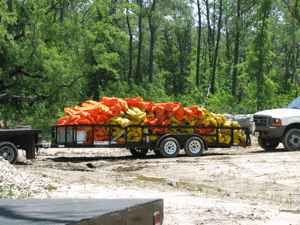
A yard used for an oyster restoration project becomes a staging ground for oil booms in Bayou La Batre, Alabama. (Photo: Ingrid Lobet)
LOBET: In a working yard on the shore of Mobile Bay, trucks loaded with neon yellow and orange boom roll in and out. This is now a spill response staging area.
[SOUNDS OF WALKING ON CRUSHED OYSTER SHELLS]
LOBET: Nearby is one of the Gulf's famous seafood canneries. And in its backyard is what might be the world's largest-ever pile of oyster shells.
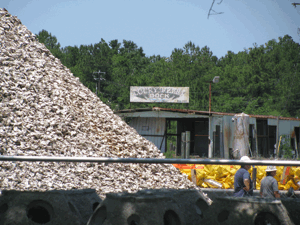
A mountain of spent oyster shells, part of a an oyster reef restoration project beside spill response workers. (Photo: Ingrid Lobet)
FINCH: We have a mountain of oyster shells. It’s huge—maybe 30, 40, 50 feet high of oyster shells, a football field long. And those oyster shells need to get back in the water, don't they?
LOBET: Bill Finch is with the Alabama Nature Conservancy. The shells need to get back into the water he says, so that baby oysters can attach to them.
FINCH: There's a lot of mud in places like Mobile Bay and sand, and oysters can't attach to mud and sand very well—they need something hard to attach to. Over tens of thousands of years oysters built their own architecture, sort of built it from the base up.
LOBET: About half of that architecture, the Gulf Coast oyster reefs, is now gone, attacked by carnivorous snails and fished out. That's what led the Nature Conservancy and other groups across 17 Gulf and eastern states to experiment with building up new reefs.
FINCH: Come up with something good for them to attach to. And the very best thing that an oyster can attach to, we've decided, is another oyster. Surprise, surprise.
LOBET: So on the days before the Deepwater Horizon oil well blew out, workers in this yard spent their time packing discarded oyster shells into special mesh bags. Then they sunk the bags offshore, building a mile of new reef. The Conservancy's oyster restoration project manager Jeff DeQuattro says everyone should care about oysters. For one thing the reefs they construct turn out to be a favorite place for fish to prowl.
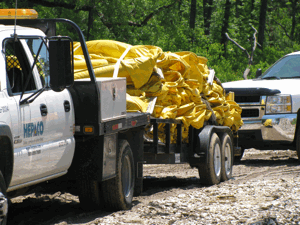
Oil booms in the truck of an environmental contractor in Bayou La Batre, Alabama. (Photo: Ingrid Lobet)
DEQUATTRO: All the Gulf species of fish, at some stage, come in contact with some form of oysters, whether it be an oyster bed, or an oyster reef. They are synonymous to coral reef.
LOBET: DeQuattro, and Marine Programs Director Judy Haner, say oysters are unappreciated filterers of water.
DEQUATTRO: Oysters filter several gallons of water a day, some say 25 gallons some say 50 gallons. It's a lot. They filter metals, they filter sediment, anything of a certain size that they can fit into their mouths.
HANER: I would say a minor sheen they could probably handle and maybe even recover from, but something that is gloppy, you know something—they are filter feeders. That is going to clog the innards if you will, and that is going to be really tough for them to save themselves from.
[SOUNDS BIRDS CALLING]
LOBET: Like Bill Finch, Haner and DeQuattro worry about the mile of new reef they've created.
HANER: This could be a big setback.
DEQUATTRO: Oysters are at pretty shallow depths, normally near shoals or near shore, so they risk being coated with oil at every stage.
[SOUNDS BIRDS CALLING, GEESE]
LOBET: If the young oysters adrift in the Gulf currents are carried into a cloud of petroleum, it will like happen just as nature is calling them to sprout a foot…to touch a rough, hard surface where they can attach and grow.

Bagged oyster shells make excellent reef for baby oyster to attach. (Photo: Ingrid Lobet)
[SOUNDS BIRDS CALLING]
YOUNG: Ingrid Lobet reporting from Alabama’s Mobile Bay. Just to the south I got on a boat for a look at the marshes of Louisiana.
[SOUNDS OF BOAT ENGINE, MAN: Hold on!]
YOUNG: In Plaquemines Parish, the oil is slowly coming ashore despite miles of booms. Some fishing grounds and oyster beds have already been shut down. This patch of Breton Sound is still clean. But scientist John Lopez fears the oil could jeopardize his group’s attempts to use oysters to protect the fragile coast.
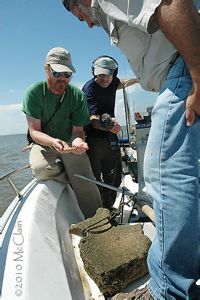
Andy Baker and John Lopez inspect part of an "oyster ball" looking for signs of growth. They hope an oyster reef will help rebuild land. They fear the oil could bring further damage. (Photo courtesy of: John Lopez)
LOPEZ: This is a location where we’re trying our oyster reef project. You’re on the edge of the marsh. Essentially, from here on out you’ve got open sound and then the Gulf of Mexico, so this little island would be one of the first areas that would be impacted if the oil did move in significant quantities into Breton Sound.
[SOUNDS OF BOAT ENGINE AND BIRDS]
YOUNG: Lopez pulls his boat up to a small patch of land where terns are nesting. He directs the coastal sustainability program for the Lake Pontchartrain Basin Foundation. He’s keeping tabs on two environmental crises out here: the oil, and the disappearing wetlands.
Louisiana loses about 25 square miles of land each year—that’s a football field every 40 minutes. Sediment from the Mississippi that once regenerated land is trapped behind the river’s levees. Canals and oil and gas pipelines cut through marsh, increasing erosion, and hurricanes rip out huge chunks. This little island was once ten acres.
LOPEZ: But about 90 percent was washed away in Katrina now right now there’s just an acre left. If something’s not done probably in just one more storm this island will be washed away entirely.
[BIRD SOUNDS, SOMETHING DROPS INTO BOAT]
YOUNG: Lopez and his assistant, Andy Baker, pull up a chunk of concrete called an oyster ball. They scrape some samples from the muck in hopes of finding the first tiny colonizers that might one day build a new reef and rebuild the marsh. Unless the oil hits.
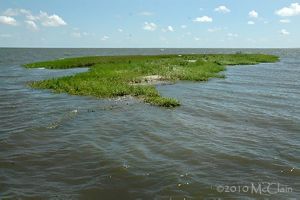
Before Katrina, this island was 10 acres; now it's just one. (Photo courtesy of Curt McClain)
BAKER: This little fragile area is one of the most vulnerable to oil. It’s really unknown if this marsh scrap can recover from oiling, or if it will be the last blow that will cause this to just completely erode into the sea.
[SOUNDS OF BOAT, OYSTER BAGS THROWN ONTO CONVEYER BELT]
YOUNG: Back at the dock in the little town of Pointe a la Hache, oyster fishermen unload hundred pound burlap sacks of oysters onto palates. These oysters are bound for the restaurants of New Orleans and beyond. Oyster fisherman Warren Duplessis says he’s lucky to still be fishing. But he knows the luck won’t hold.
DUPLESSIS: Oh yeah. Ain’t no couple of booms going to be able to hold it back. Magnitude of that spill, ain’t now way you gonna be able to stop all of it. And once it gets in the marsh you done lost the fight. I don’t know, the animals dying and then they feed on, because that’s where they breed at in the marsh. You take that away, well take away the seafood, and take away us, and domino effect, you know.
YOUNG: But, what happens to you if that happens?
DUPLESSIS: [Laughs] I guess I gotta try to find another line of work, I guess. You know. Either that or starve to death. It’ll be hard for a lot of people. It really will be. That is they whole life you know? From generation to generation. All their life know nothing but the bayou, nothing but the water. They change with the season. When it’s shrimpin’ season they’ll trawl, when it’s oyster season they fish oysters, crabbin’ they’ll crab. Whatever to make a dollar to support their family.
[MEN SHOUTING, JOKING: Tie that rope tie that rope! What’s wrong with you?]
YOUNG: A quick look around reveals something else at stake here. An African American trucker chats with a Mexican American oysterman. Men joke and swap stories in thick Cajun and Creole accents. The bloodlines are as mixed as the water, and the communities are as tight as the marsh grass roots.
DUPLESSIS: Down here this is tight-knit community, it really is. They ain’t a person that everybody don’t know everybody—who they are, what they about, where they from, they momma, they grandma, they children they nieces and nephews. That’s how close it is down here. Just pick a lane, you can say go down two miles and second lane to such and such and I could tell you who stay there, where they people at, and what they gonna be doin’ his evening. [Laughs] Just about, eh?
YOUNG: So, I guess, the big question is if oyster beds die, if shrimping is closed down for a long period time, what happens to all that?
DUPLESSIS: Well, that’s the million dollar question you know.

Host Jeff Young interviews John Lopez. (Photo courtesy of Curt McClain)
YOUNG: The uncertainty hangs thick. Nearby, Rodney Echelard sits in the shade. His face shows the work, weather and worry of 30 years on the water. He’s a deckhand now. He once captained an oyster boat until it was lost in Katrina.
ECHELARD: See when Katrina hit us that destroyed us big time. You know it took all our homes, just wiped us out. We just coming back and the oysters is coming back. Then this happened, well, going on again. We trying our best to get what we can while we can before they kill all our oysters.
YOUNG: Do you have any confidence that BP is going to make things right if oyster beds are damaged and you can’t work there anymore?
ECHELARD: I sure hope so. But my confidence is shot so far what I been seeing. I sure hope so because man, it could be a lot of years and a majority of people down here that’s all they do—you know, fish—they’ve been doing this all their life, fishing oysters. If things don’t go right, well, how can they live? Oh yeah, Bro. Hard times, dude, hard times. Right now? Yeah, it’s hard times. Yes.
Links
Full transcript of the President’s remarks and May 27 press conference
USGS flow estimates of oil coming from BP Deepwater Horizon accident site
Click here to read the Department Of Interior’s report on increased safety measures
Click here to read the Department Of Interior’s report on MMS.
Living on Earth wants to hear from you!
Living on Earth
62 Calef Highway, Suite 212
Lee, NH 03861
Telephone: 617-287-4121
E-mail: comments@loe.org
Newsletter [Click here]
Donate to Living on Earth!
Living on Earth is an independent media program and relies entirely on contributions from listeners and institutions supporting public service. Please donate now to preserve an independent environmental voice.
NewsletterLiving on Earth offers a weekly delivery of the show's rundown to your mailbox. Sign up for our newsletter today!
 Sailors For The Sea: Be the change you want to sea.
Sailors For The Sea: Be the change you want to sea.
 The Grantham Foundation for the Protection of the Environment: Committed to protecting and improving the health of the global environment.
The Grantham Foundation for the Protection of the Environment: Committed to protecting and improving the health of the global environment.
 Contribute to Living on Earth and receive, as our gift to you, an archival print of one of Mark Seth Lender's extraordinary wildlife photographs. Follow the link to see Mark's current collection of photographs.
Contribute to Living on Earth and receive, as our gift to you, an archival print of one of Mark Seth Lender's extraordinary wildlife photographs. Follow the link to see Mark's current collection of photographs.
 Buy a signed copy of Mark Seth Lender's book Smeagull the Seagull & support Living on Earth
Buy a signed copy of Mark Seth Lender's book Smeagull the Seagull & support Living on Earth

